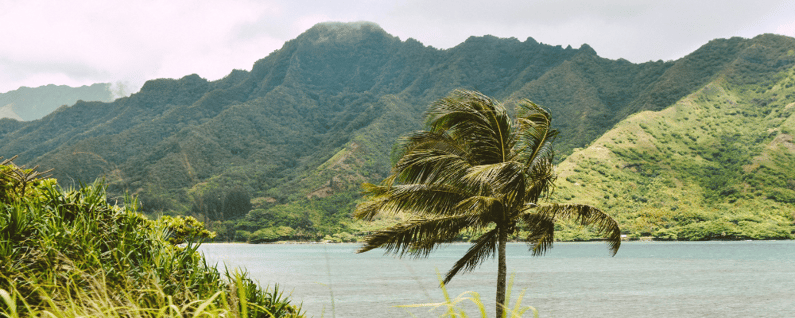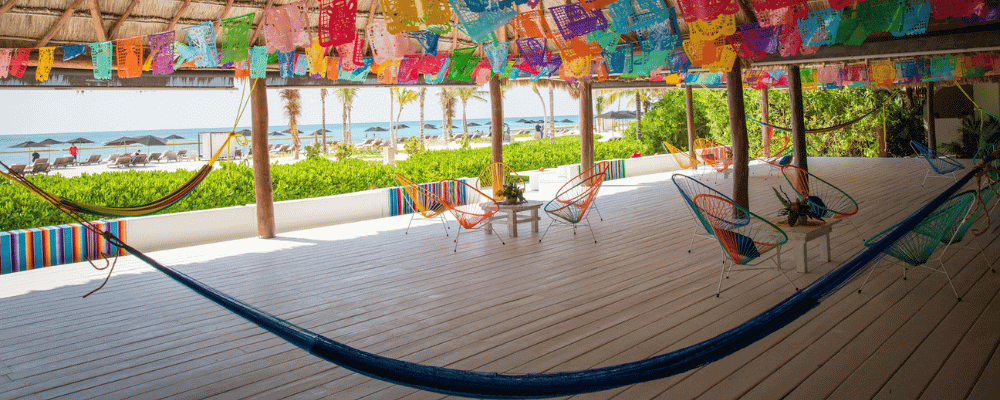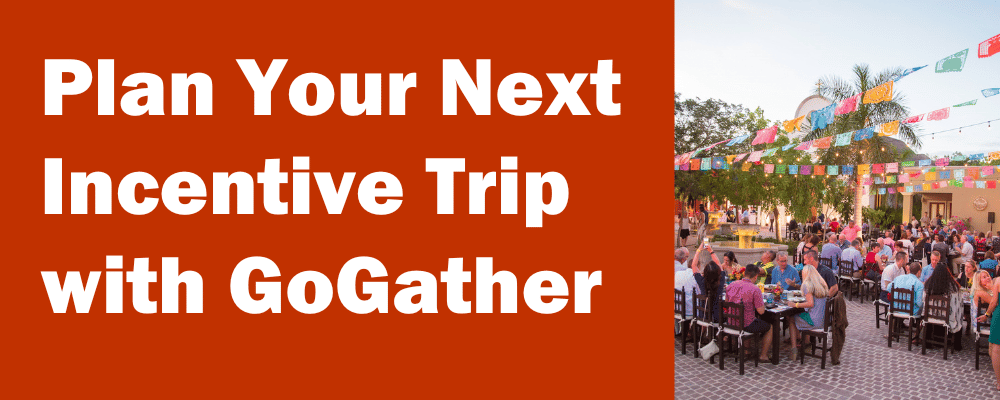Incentive trip planning for 2026 (and even 2027) is already well underway, and just like the year before we keep saying "what could possibly top last year?"
From record burnout to high employee turnover, this year is set to make incentive trips an important business strategy. But there are also important considerations around cost that are starting to reveal themselves in overwhelmingly large bills.
Let's take a look at our top six incentive travel trends for 2026.
2026 incentive travel trends.
Value is a must.
Incentive trips are no longer considered a must-have by many companies. We're seeing budgets get slashed, attendance numbers reduced, and even trips get completely canceled. So how do you ensure your incentive trip is seen by leadership as something to keep rather than cut?
It's all about ROI. How can you prove your event is worthwhile and, in fact, beneficial for the business?
Traditionally, ROI (or return on investment) measures an event’s success based on numbers-driven metrics like revenue gained or leads collected. But as As Katie Moser Stuck, our Director of Marketing and Business Development, noted in an interview with Prevue Meetings:
“While bean counting will always play an important role, more organizations now are leaning into a new type of metric — return on engagement, or ROE (return on engagement).
ROE is not easy to directly measure, but it’s very important for the long-term success of an organization or a business.”
This shift toward ROE reflects a broader understanding of incentive travel’s impact. While numbers matter, leadership also wants to see how programs influence behavior, morale, and engagement over time.
We recommend building out a business plan that outlines the challenges your company has (employee retention, declining sales, or even low motivation), how incentive travel can solve those issues, and an outline of how the program would work (including its value, the costs, and logistics).
Plus, it doesn't hurt to have some stats to back you up: See all the statistics that show the value of incentive programs.
Different incentives for different employees.
Generational preferences and life stage are often key considerations when designing incentive, reward, and recognition programs to motivate employees and salespeople, according to a study by the Incentive Research Foundation from 2023.
Here are some insights from the Generational Expectations of Incentives to consider when planning your next incentive program:
- Younger individuals aged 18-30 and those with higher incomes tend to have a greater preference for group reward travel compared to others.
- Workers in the later stages of their careers (51+) have a strong preference for domestic travel destinations that can be reached by driving, rather than those that require flights.
- Younger workers (18-30) are much more drawn to merchandise (electronics, etc.) and experiences (concerts, etc.) than mid-career and late-career stage workers.
- Programs that utilize points, gift cards, and spiffs align with younger workers’ preference for frequent, authentic recognition.
Here are some key takeaways from the study on workplace reward preferences between men and women that can help when designing your rewards programs:
- Research shows that women are generally more inclined toward non-monetary rewards compared to men.
- Interestingly, when non-monetary rewards are vividly described, many recipients—men included—often shift their preference from cash to a compelling non-monetary reward of equal value.
- There’s also a difference in how men and women prefer to be recognized; men tend to favor “big show” recognition, while women might appreciate quieter acknowledgment.
- It's important to remember that preferences vary widely within each gender, so the more personalized the reward program, the more impactful it will be.
To ensure that your employees are satisfied with their rewards, it's important to recognize and cater to the diverse interests of individuals in your company. This will help you effectively tailor incentives to meet their needs and preferences.

Unique experiences are on the rise.
According to the Incentive Research Foundation, there is a strong drive within organizations to visit destinations that are new to their group, with 71% of respondents to the 2023 Incentive Travel Index citing this as a priority.
Unique experiences are gaining momentum in incentive trips for companies, reflecting a shift in employee preferences for more unconventional and exciting options.
Employees are increasingly seeking out one-of-a-kind experiences and the chance to immerse themselves in new cultures and thrilling adventures. They desire something beyond the ordinary beach vacation and are interested in options such as exhilarating off-roading trips or ziplining through the jungle.
Think through how you can design a program beyond the simple beach vacation. Maybe that's completely changing up your itinerary or just adding in a few unique activities throughout.
Take a look at some of the amazing destinations we have created sample incentive travel program itineraries for:
- Sample Incentive Travel Program Itinerary: Costa Rica
- Sample Incentive Travel Program Itinerary: Florence, Italy
- Sample Incentive Travel Program Itinerary: Mallorca, Spain

Traveling further abroad.
Enthusiasm for incentive travel remains high, as does excitement for the destination. According to the Incentive Research Foundation, 70% of respondents extended their international incentive trips.
Employees are increasingly drawn to incentive trips that take them further abroad. We've noticed a growing interest among employees in incentive trips that offer opportunities to explore different cultures, discover exotic destinations, and engage in unique experiences. This is a change from just after the pandemic, where most preferences were to stay stateside.
Plus, international incentive trips offer an incredible opportunity to add excitement and prestige to your event. They have the power to motivate employees to not only participate but maybe work that extra bit harder to attend.
Costs are increasing anyway.
Although many programs are seeing budgets stay the same or even decrease, it's important to note that prices continue to rise. This is important to keep in mind: what might have worked in 2019 isn't necessarily going to work in 2026.
The industry is grappling with the growing concerns of inflation and economic pressure. The 2023 Incentive Travel Index reported that 76% of respondents indicated rising costs and inflation as a challenge.
And for travel incentives, rising costs for hotel, air, and food and beverage – which comprise 65% of the average incentive trip – will continue to squeeze out dollars allocated to inclusions, gifting, etc.
With costs increasing, you'll need to be extra firm in your argument for investing in incentive travel as a strategic way to reward employees. Sacrificing on experience to meet previous years' budget numbers isn't always the way to go.
We always say that creativity is not a function of budget; you can accomplish a lot with limits on your budget. However, when considering your incentive trip, it's important to consider how a constricted budget can negatively impact the experience and weigh the pros and cons.
We also recommend our clients look at their annual incentive program budget as a percentage of their overall revenue (especially of their top performers) to understand how the incentive travel budget may or may not be impacting the business year over year. You may find that although the budget is staying the same, it's actually decreasing as a percentage of overall company revenue (since your company's revenue is increasing).
Incentive travel isn't just for internal employees.
Incentive travel extends beyond internal employee rewards; it serves as a powerful tool for client incentives, partner recognition, and dealer incentives. We're seeing these types of incentive programs driving immense value for our clients, and increasing in popularity across the board.
Client incentives.
- Client incentive travel is a great way for businesses to show their appreciation, enhance client relationships, and stand out in competitive markets.
- By offering tailored travel experiences as incentives, companies not only motivate clients but also create lasting impressions that foster loyalty.
Partner incentives.
- According to a recent report by Canalys Research, businesses are shifting their focus towards incentivizing partners to generate recurring revenue streams instead of relying on one-off product sales.
- This new approach offers businesses a strategic way to recognize and reward valuable partners, creating a more sustainable business model.
Dealer incentives.
- Dealer incentives provide a targeted approach to motivate and reward dealers, driving sales performance and creating a mutually beneficial partnership.
- These incentives aim to recognize and reward top-performing dealers, motivating them to achieve sales targets and strengthen their commitment to the brand.
Consider how you can incorporate one or all of these types of incentive programs into your business to drive greater value for the companies that make up your network.
Related: Wondering who’s turning corporate travel into something worth talking about? This article breaks it down.
View our 2025 trends (they're still relevant today!)

Retention is more important than ever.
We all know the last couple of years have been rocky with employee turnover and uncertain economic markets. Retaining top talent is vital in 2026.
Gartner predicted that the business sector could see the turnover rate jump 20% from pre-pandemic levels, up to an almost 24% turnover rate.
High turnover means increased costs, lost productivity, and ultimately declining business performance. Especially when it comes to top performers, businesses can't afford to lose talent.
Incentive trips are one of the many strategies businesses can use to facilitate that employee retention by making top performers feel valued.
According to a 2021 study in the National Institutes of Health, "Organizations that offer strong benefits and incentives to employees reduce the likelihood of turnover by 26% and increase retention by 14%."
Offering incentive trips can not only make your teams perform higher but can give them the reward they need for their hard work. Recognizing their achievements and providing them time to relax and recharge will reinforce company loyalty and job satisfaction.
Learn why non-cash rewards are better than cash rewards for employee motivation and satisfaction.

Connections are vital...
Work-from-home environments persist into 2026, which can often lead to employee disengagement. A study by BetterUp found that "lack of connection in the workplace negatively impacts employee retention, performance, well-being, and more." The study reported that 52% of employees want more connections at work. Stress, anxiety, and burnout have all increased dramatically.
Meanwhile, the report also says that highly connected employees experience an increase in well-being, positive relationships, and professional growth.
When retention is so important to companies, taking care of your employees has to be a top priority. Connection is key to their well-being, and incentive trips should be a part of that strategy.
Incentive trips offer a fun way for teams to bond and build connections. As you plan your itinerary, make sure to be intentional about what activities you're planning and when. Make your outings small enough that people can feel comfortable interacting.
Find ways to initiate conversations among attendees, even if it's just through your seating arrangements. Don't expect these connections to just happen -- think through how you can facilitate them.

...But downtime is important.
While connections are important, make sure you aren't jam-packing your trip so much that your employees feel like they need a vacation from their vacation.
Trends from the Incentive Research Foundation indicate that 89% of survey participants find "being given ample time to relax" is important. Incentive professionals agree, with 46% saying downtime is key to a successful incentive program.
Downtime can also help with reducing costs (hey, we'll get to that trend next). Allowing time for participants to relax by the pool, soak up the sun, and swim in the waves means you can reduce the number of group activities and cut down on costs a bit.
As you build out your incentive program itinerary, think about a balance of free time and group activities to make the trip really impactful for your attendees. We always encourage our clients to build in that free time on the first full day of the trip to help guests adjust to new time zones, relax after a long day of travel, and truly soak up their earned vacation.
As Katie Moser Stuck, our Director of Marketing and Business Development, noted in an interview with Prevue Meetings:
“If you’re in a large hotel or convention center, attendees usually can’t trek all the way back to their room to get 20 minutes of quiet. Planners can accommodate that by having relaxation stations available within the event space. It doesn’t have to be elaborate, just quiet places people can decompress and not be expected to participate or network.
Also, build a little space between sessions into the agenda. Or maybe give them a little time after lunch to go outside or have a walk.
It’s all about finding that balance between giving them all the content and networking they signed up for and the quiet time they need to be able to absorb it all.”
"Downtime" also doesn't have to mean nothing is planned. You can offer some lowkey activities around the resort for people to participate in (because not all of us are good at sitting by the pool and reading for 5 hours).
Some downtime options include spa sessions, golf or tennis, yoga lessons, paddleboarding, painting lessons, cornhole, and nature walks.

This isn't 2019 anymore -- inflation is biting.
We've all felt the effects of inflation in our lives. The event industry has also seen the impact rising costs can have on our budget, and we have to get realistic about what things cost post-pandemic.
For many of us, 2026 might be the first year that we're really diving back into incentive travel. That means we're comparing budgets to the "before" years, when the world looked very different.
Make sure you aren't holding your trip to unrealistic (AKA 2019) expectations. Adjust your budget for inflation, figure out where to cut unnecessary spend, and consider whether there are lower-cost locations you can select.
For more tips on how to stay on budget during inflation, check out our guide.
There is an upside to inflation. According to the Incentive Research Fund, 50% of North American respondents said high inflation increased the perceived value of non-cash incentives.
That means your incentive trip can feel more valuable than an annual bonus, especially when individuals might be cutting back on "fun" spending like vacations.
Even on a tighter budget, you may reap more benefits from offering that annual incentive trip than a cash bonus.

Increased focus on wellness.
Health and wellness are booming.
McKinsey predicts the spend on products and services in the wellness industry to be $450 billion in the U.S., with a 5% annual growth.
And it's no surprise.
Burnout is high. Future Forum found that 42% of workers reported feeling burnt out between November and December of 2022.
That's why well-being has become a huge part of the narrative in the workplace. Companies have placed greater emphasis on providing wellness services to employees and helping them combat burnout (because, as we know, retention is highly important these days).
In fact, Gallup reports that employees that are struggling are twice as likely as thriving employees to change jobs. The report also says that "employees who strongly agree that their employer cares about their overall wellbeing, compared with other employees, are 69% less likely to actively search for a new job and 3x more likely to be engaged at work."
Incentive trips are an ideal time to make your top performers, who you want to make sure stay at your company, feel supported in their well-being
There are countless opportunities to help your employees with their well-being during your incentive trip. Some ideas include:
- Morning yoga or workout sessions to support physical health
- Journaling, meditation, or inspirational conversations to boost mental wellness
- A relaxed environment to connect with other employees and support social wellness
- Healthy cooking lessons, juice stations, or other wellness foods
- Activities that your participants love, such as golf or painting. Really make sure you know your attendees when you book activities
Consider a location like a wellness retreat for your next incentive trip, or find a place with plenty of activities to suit your guests' needs. Here's a guide to selecting the right destination for your incentive trip.

Sustainable tourism is on the rise.
Sustainability is a rising topic, with increased awareness being given to the impact of flying and traveling on the environment.
The Global Sustainable Tourism Council defines sustainable tourism as the "sustainable practices in and by the tourism industry. It is an aspiration to acknowledge all impacts of tourism, both positive and negative. It aims to minimize the negative impacts and maximize the positive ones."
Statista reports that 5% of carbon dioxide emissions were caused by tourism-related transport in 2016, with a prediction to rise by 2030. Additionally, Statista reports that 81% of travelers believe sustainable travel is important.
As you plan your incentive trip, consider how you might be able to reduce your carbon footprint throughout. Ideas include:
- Reduce flight length for participants by hosting the incentive trip somewhere closer to home. Consider also how transportation times on the ground might impact the environment. Can you find a resort closer to city centers and airports?
- Partner with resorts that place an emphasis on green practices. From reducing water usage to leveraging reusable materials to installing solar panels, there are many ways hotels can put sustainability into practice.
- Consider the footprint of your gifts. From packaging to shipping, gifts can increase your carbon footprint. Consider locally-created goods that don't have to travel far, in low-waste packaging. Also take into consideration whether the gifts themselves are sustainable or recyclable.
- Arrange sustainable activities. What impact are your activities having on the environment? Consider low-impact activities that don't produce a lot of carbon or interfere with the natural environment.
- Reduce waste and reuse materials. Things like branded napkins can be wasteful extras that might not be necessary. Consider how you can swap out items for more sustainable alternatives, or do away with them altogether
Careful planning and asking the right questions will be key to ensuring your incentive program hits your sustainability goals. Read more about planning a successful incentive program that hits your goals here.

Let's give back.
Corporate social responsibility has been at the forefront of business conversations for years.
This year we expect CSR activities to continue being incorporated into incentive trips.
Google the term "giving back while traveling", and you get endless articles about ways to volunteer while you travel. The term "responsible tourism" is all about "making better places for people to live in and better places for people to visit."
As we travel to new locations, especially communities that are underserved, we can find ways to give back to those local communities and thank them for sharing their culture with us.
We encourage our clients to consider give-back activities that get attendees involved with the local community. This can be anything from donating school supplies to local schools or organizing a beach cleanup.
Especially as the world continues to recover from the pandemic, grapple with rising costs, and face uncertainties into the future, it will be important to incorporate ways to improve the communities you visit.
What trends are you seeing?
As you plan your incentive trip this year, let us know what trends you're seeing and how we can help you plan for them. Let's chat about your upcoming incentive program.
Looking for a list of the top incentive travel companies? Here's our list of the top 10 partners that are sure to make your incentive trip stand out.





